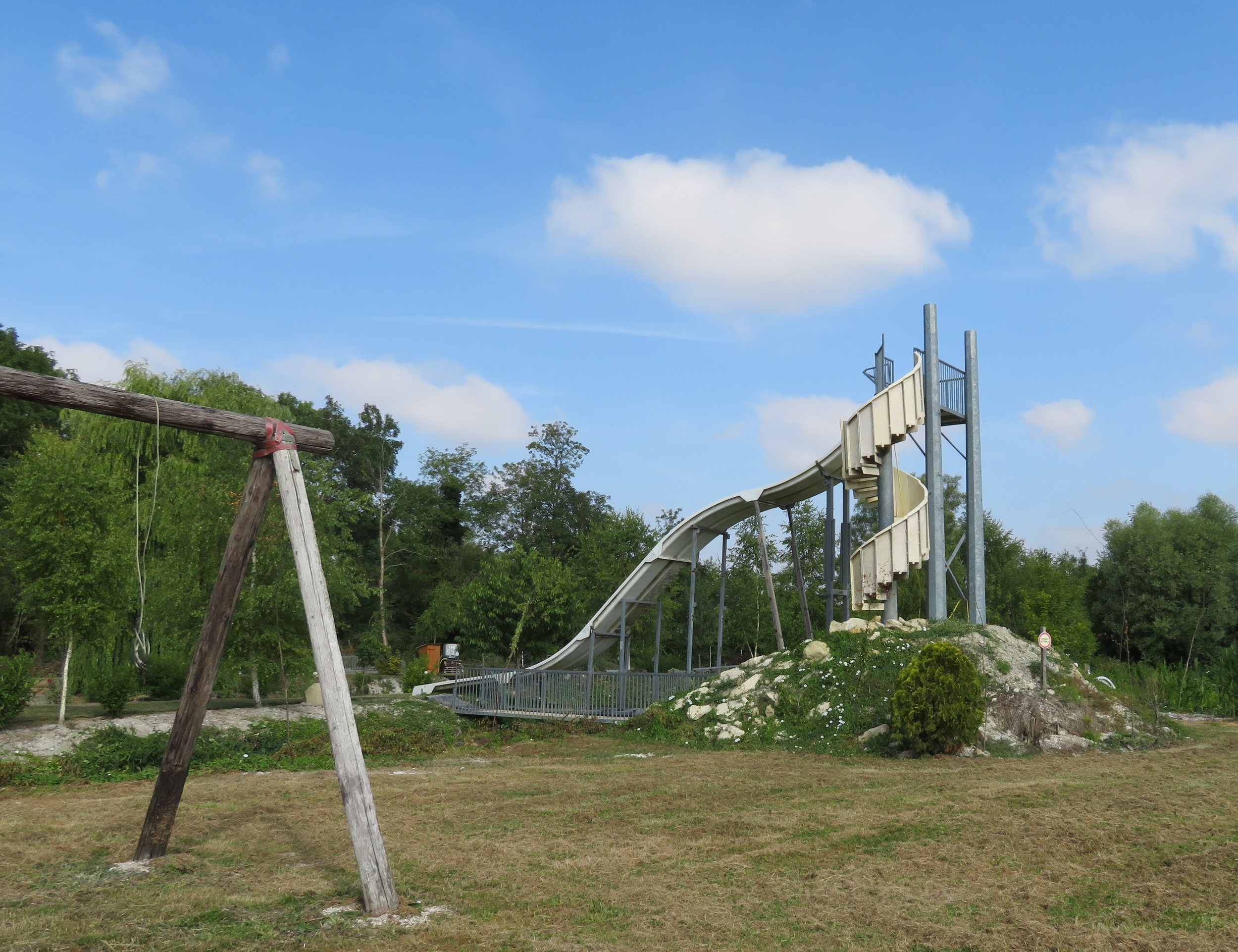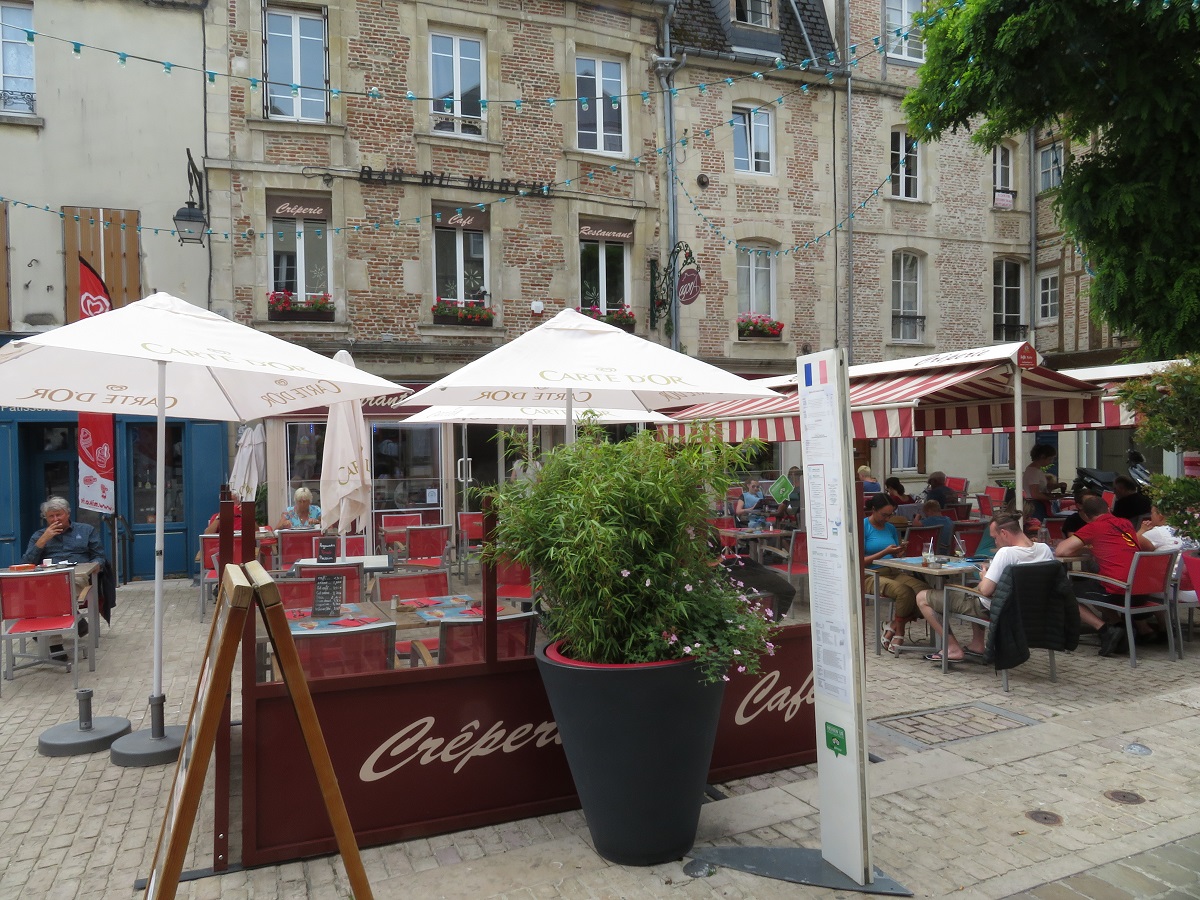Beavers, Oxen and Boar-dom
/Day 74 – Berry-au-Bac – Ste. Croix
We left the MO-tel des Nations without brekkie. The Tabac/Bar down the street offered coffee, but no food. The boulangerie next door was closed from mid-July through August. We munched on our cache of granola bars with our coffees, then set out on our way.
This big slide was calling my name!
We trudged through corn fields and wheat fields. We’re leaving the Champagne region now and the terrain is changing. In the middle of nowhere, in a clearing across the street from a large cornfield, we came across a huge slide that just beckoned me to try it out. Unfortunately, it was fenced off and the stairs to the top were missing … a deterrent for sure. We took a rest break there anyway and wrestled two plastic chairs into use. It appeared to be a small water park of some sort, now apparently abandoned, though the grass was mowed. Paddle boats in obvious states of disrepair were lined up on the shore of a murky, weedy, little pond.
It was a short walking day, comparatively speaking, only 11 miles. We stopped at a boulangerie in the pleasant little town of Corbeny at the 7-mile mark and finally had our breakfast on a picnic bench next to the village church. Since it was closer to lunch than breakfast, we indulged in Magnum bars, too.
Église Saint-Marcoul de Corbeny
Corbeny’s 12th century village church, by the way, was totally destroyed in WWI in 1919 since this town was an active battlefield. We talked about what it would have been like to have a battlefield in your little town … what it must be like to see your village church and homes destroyed and have the enemy at your front door … in your home. The church was totally rebuilt by 1929.
We continued on to St. Croix, a very tiny village and our goal destination for the day. After last night’s disappointing accommodations, La Besace was exactly the opposite … it was wonderful. If you can imagine a picturesque, idyllic French country inn, this was it. Our room was comfy with lots of little amenities. Aga, our host, was awesome. There are no restaurants or amenities in town, but it didn’t matter. A 4-course excellent dinner was cooked and served in a small, cozy dining room. A lovely evening and a good night’s sleep.
Day 74 – Berry-au-Bac – Ste. Croix
11.04 miles walked / 25,677 steps
Leg distance: 11 miles / 257 miles to Canterbury
Day 75 – Ste. Croix – Laon
We wanted to leave early, so Aga had our breakfast ready by 0630 and, to our surprise, packed us a lunch to take with us. We stopped at a park bench in the village of Bièvres to eat our lunch and noticed a large, silver beaver sculpture in front of the Maire (town hall). No clue was provided as to why it was there. Bièvres does not translate to beaver… that’s castor in French. We discovered later that in ‘old French’ bièvres does indeed mean beaver.. Huh, another mystery solved.
The beaver of Bièvres … always something new to discover.
The path today was a mix of farm roads and forest paths over hilly terrain. When we came over a rise, Laon popped into view. Set high on a hill several miles away, it is another fortified, walled medieval city and we planned to take a layday there.
On the Via Francigena, the towers of Laon’s Cathedral pop into view
We found the Hotel Tramway next to the railroad station. It was comfortable and pleasant and our base for a couple of nights. After rounding up supplies for dinner, we relaxed and whiled away the evening.
Day 75 – Ste. Croix – Laon
12.82 miles walked / 29,821 steps
Leg distance: 13 miles / 244 miles to Canterbury
Day 76 – Laon – Versigny
Because we couldn’t find accommodations in Versigny and didn’t want to walk a 22+ mile day, we opted to do a Plan B day, i.e. leave our packs in the Laon hotel, take the train to Versigny since there were only two trains per day that stopped there, and then walk back to Laon. We were up early to catch the 0657 train and on the path by 0715.
We were on country roads for a short distance then entered a local nature reserve and walked along a heavily forested path. Something moving on the path in the distance caught my eye. We couldn’t figure out at first what was on the path. Something moved; then several little somethings; a bigger something and then Big Daddy appeared, tusks and all, and there was no doubt in our minds what they were … the whole damn Boar family, all trotting merrily up the path to greet us.
The whole Boar family was trotting towards us.
We discussed our options. Plan A … take out our trekking sticks, look big, make a lot of noise and try to scare them off. Plan B … run like hell into the forest and hide behind a big tree. Well, I’m glad to report Plan A worked. We shook our sticks, hollered and waved and the family scattered into the forest. We hurried along quickly while listening to menacing grunting only a few yards away. Suddenly one little piglet (boar-let?) appeared in the path. Frightened and confused, it headed right for us. We could hear Dad and Mom snorting, ready to come to their baby’s aid. Finally, it swerved off the path towards safety … his and ours. Further down the path, we heard more grunting and saw 5-6 more young ones dart across the path.
We’ve met boors along our life’s path; we’ve even been bored on occasion; but we’ve never met a whole family of wild boars before and quite honestly, we’re not sure we’d like to meet them ever again. We were relieved to be out of the forest and heading back into the city of Laon.
Day 76 – Laon – Versigny
14.33 miles walked / 33,333 steps
Leg distance: 14 miles / 230 miles to Canterbury
A Day in Laon
It must seem that we’re always taking laydays, but it really isn’t so. We’ve been trying to take a day off every 4-6 days because (1) we want to enjoy these wonderful French cities we’re in and, more importantly, (2) we just need to recharge.
Lots of stairs to climb up to Laon’s old city … always looks easier when you’re looking down!
Medieval French cities are wonderful. We’ve loved them all … Besançon, Langres, Reims and now Laon. Like most fortified cities, it is walled and sits high on a hill overlooking the flatlands below. Our hotel happened to be in the ‘flatlands below’ and thus, we were charged with climbing the very steep ‘escalier’ (stairs) to the old city. When we reached the top of the stairs, we walked on a ramp that ran alongside an old funicular railway and climbed the rest of the way to the top.
Laon’s Notre-Dame Cathedral
The Notre-Dame Cathedral of Laon, built between 1150-1180, is considered a masterpiece of early Gothic architecture. The towers are amazing. The detail is superb and the gargoyles, chimeras and grotesques (my favorite) are outstanding. You know the drill … click the image to enlarge it.
Like many French cities, there is always an icon with which the city identifies and in Laon it is the oxen which adorn the towers of the western facade. The 12th century legend of the Cathedral oxen was recounted by a monk. When the Cathedral was being built, oxen were used to haul heavy loads of stone and supplies up the steep hill. On one particular occasion, the oxen were struggling and a mysterious ox appeared from nowhere, helped get the load to the top and then disappeared. The incident was considered miraculous and hence the colossal oxen that now adorn the Cathedral towers.
The legendary oxen memorialized forever!
Inside, the Cathedral is enormous, but quite simple, a Cistercian influence of the time. We wandered about then met Thomas, a young, amiable seminarian from Paris clothed in a white cassock who provided more information about the Cathedral and found us a stamp for our pilgrim passports. We saw him later on in the afternoon in street clothes as he was biking out of town.
Inside Notre-Dame of Laon
The weather was sunny and warm and absolutely lovely. Lunch was outside dining at a creperie in the shadow of the Cathedral and though we were out of the Champagne region, we still indulged in a glass just because we could.
Other than residents and deliveries, no vehicles are allowed in the old city. Streets were filled with people and restaurants spilled out beyond the sidewalks. Colorful umbrellas and tinsel hung from overhead and the atmosphere was festive and joyous. I love the decorative and descriptive signs that hang from so many of the shops and restaurants.
We checked out the 13th century Soissons Gate, one of several portals entering the old city. Beside it, the tower of Lady Eve slipped off its foundation in the 12th century and has been leaning ever since.
Soissons Gate
Leaning Tower of Lady Eve
The Abbey of St. Martin, also built in the 12th century, was closed to visitors unfortunately. The Chapel of the Knights Templar, built in 1140, was also closed for renovations which was a pity because I was really looking forward to exploring and learning more about it. We at least had the opportunity to see and photograph both.
Abbey of St. Martin
Chapel of the Knights Templar
And then the day was over and we were finding out way back down to the hotel and planning tomorrow’s walk.
Next time … We’ll be walking through the villages of WWI’s historic Western Front. Our time in France will come to an end soon. And our countdown begins.




























